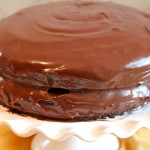|
||
If you are thinking about changing your diet, and you want to notice some big changes, I suggest you look closer at the flours that you use in your everyday baked goods. One day, while in the kitchen, I asked myself “what if I started using whole wheat flour in some of my recipes?” In an attempt to make my recipes healthier this year, I have had to start substituting certain ingredients to make them friendlier to the health conscious consumer. As I was thinking about how this would affect my baked goods, I ended doing some research into the real differences between enriched white flour and whole wheat flour. The research was eye opening. Some of the following information may effect how you bake from now on, so read carefully!
Most of you probably know that white flour is made from heavily refined and processed wheat grains, while whole-wheat flour is made from grains that have not undergone heavy processing. A whole wheat grain has three parts to it and they are the bran (outer shell, contains fiber, B vitamin), the endosperm (provides energy, carbohydrates), and the germ (nourishment for the seed, antioxidants, B vitamin, and vitamin E). Whole wheat flour uses all three parts of the grain while white flour only uses one part of the grain, the endosperm. This means that whole-wheat and white flours are very different in their nutritional value. What does this mean for you and I?
In a study performed by Colorado State University, it is found that a 1/2 cup of whole wheat flour contains 6.4 grams of fiber and a 1/2 cup of white flour contains 1.3 grams of fiber. Fiber is essential to our diet and it can prevent constipation, lowers blood cholesterol and it can help you lose some of those unnecessary pounds that you gained over the Holidays. Since whole wheat flour uses all three parts of the whole grain (the bran, endosperm, and the germ) you will feel full for a longer period of time because it will take your body a longer time to digest it. Meanwhile, white flour is digested much faster than whole wheat flour because it is a much finer flour (only uses the endosperm).
Another flour that is a great substitute for white flour is enriched white flour. In the process of making white flour, many of the grains’ vitamin content are lost form the original whole wheat grain. To combat this, many white flour manufacturers enrich their white flour with the lost vitamins and fibers. The end result is that enriched white flour and whole wheat flour have similar nutritional content. The only downside to enriched white flour is that it is not nearly as natural as whole wheat flour even if the nutritional values are similar.
|
||
All this being said, you don’t have to start using whole wheat flour in everything that you bake. However, it does mean that substituting half of the white flour (preferably enriched white flour) in your recipes for whole wheat flour is a great idea. It is recommended that half of the grains that you eat on a daily basis are whole grains. Making the switch to whole wheat flour will make that a whole lot easier.
On a side note, whole wheat flour does still contain the same amounts of carbohydrates as refined flours do and whole wheat flour does change the taste in recipes, especially in your pastries, so beware of that. I hope you take this information to heart and have fun playing around with whole wheat flour in your next several baked good recipes! Want to bake with whole wheat flour now? Try some Coconut Oatmeal Cookies with Dark Chocolate Kisses.
|
||
|
||





















